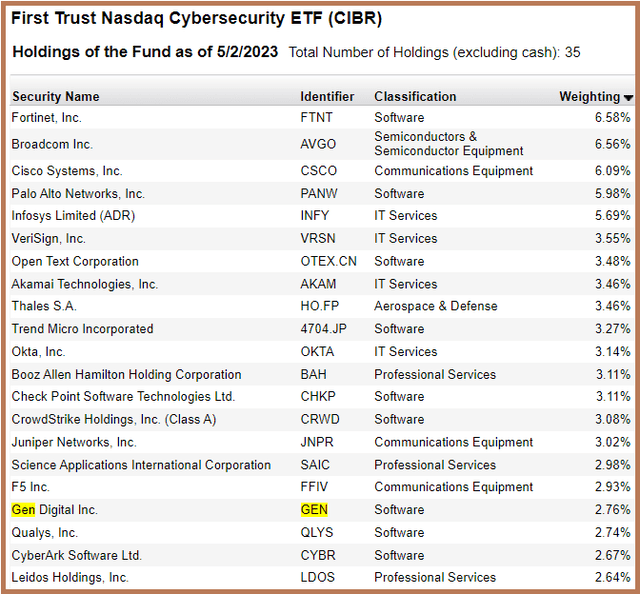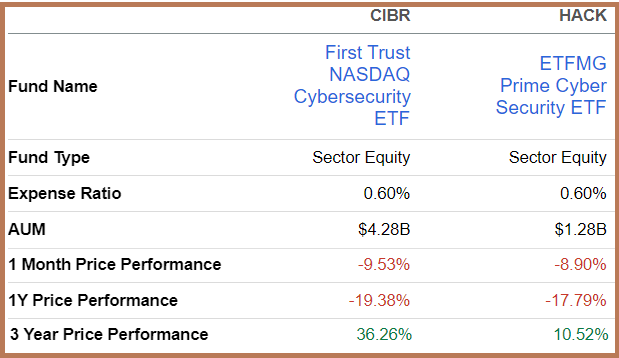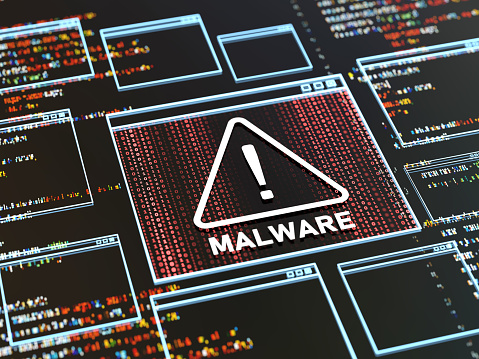Every day you hear of the new opportunities available with generative AI tools like ChatGPT. Developed by OpenAI, its adoption is now being driven by Microsoft (MSFT) and one hundred million users were already hooked in February for performing everything from writing reports to computer codes. Alerts have been raised on the regulatory aspect, but we don’t hear much about the cybersecurity damages.
These risks are real as I will explain later, and, the aim of this thesis is to show that with its front liners in the detection and resolution of IT security threats, the First Trust NASDAQ Cybersecurity ETF (NASDAQ:CIBR) should benefit from new market opportunities. Twenty-one of its thirty-five holdings are pictured below.
CIBR’s Holdings (www.ftportfolios.com)
For this purpose, I will mainly use reports from two of its holdings, Gen Digital (GEN) and Cisco (NASDAQ:CSCO), but, for now, it is important to provide clarifications about the dangers by using the analogy of the personal computer with its GUI or graphical user interface.
Highlighting Dangers Using the GUI Analogy
Before the GIU, computers were blank terminals with just an MSDOS prompt where you could only type commands, usually done by experts who had followed specific training. Now, with the nice Windows interface, you just have to click using a mouse to launch applications. In the same way, ChatGPT provides you with an easy-to-use interface to query the system about everything using the language you use every day without having to learn complicated AI codes.
Thus, the possibilities are enormous, both for doing good, or bad.
According to Norton’s (now Gen Digital) global research team in its Pulse report, this ease of doing things allows for the creation of sophisticated threats by cybercriminals who use can ChatGPT to improve their phishing skills. This is extracting (or fishing for) vital data like bank details from unsuspecting users, but, worst, hackers can potentially create “deep fake chatbots”. These impersonate (look like) the real thing (ChatGPT), and when the application is launched it can extort data or compromise IT systems and ask for a ransom to bring it back online, thereby committing fraud.
As per Cisco, ChatGPT-style AI will make it harder for security teams to detect phishing attempts as they provide hackers with more customization options. Hence, when hackers send emails to people with the aim of tricking them into opening the attached malicious link, they are likely to customize those into more targeted attacks that stand a better chance of being successful compared to sending more generalized missives in the hope of catching people off guard.
Now, since about 80% of illicit computer accesses already originate from phishing, one can imagine the nightmarish scenario IT security managers are likely to face as more users get lured into hackers’ schemes.
Therefore, by allowing hackers to improve their techniques and also considering the hype aspect whereby people are attracted to all words including Chat or GPT, the new AI technology brings more vulnerabilities, but, it does not mean that cybersecurity companies have to develop protection mechanisms from scratch to address these.
AI-Base Protection
Thus, giving hackers a taste of their own medicine, CIBR’s top-holding Fortinet (NASDAQ:FTNT) already makes use of AI to keep up with the huge volume of data generated by its routers and firewalls, and this, since 2022. In fact, given the sophistication of today’s cyber threats, and the speed at which they are generated, it would simply have not been possible for conventional IT to deliver on the security mandate. Therefore, it is only with AI-driven tools that the company can deliver advanced monitoring, and threat detection, as well as mitigate zero-day attacks. These occur when a flaw is exploited before IT security professionals have an opportunity to address it.
Looking further, cybersecurity companies can defend their clients’ IT systems using baits in the form of “honeypots” for luring cyber criminals so that engineers can study their attack patterns while keeping the actual data safe. Thus, according to Nvidia’s (NASDAQ:NVDA) Chief Security Officer, such utilization of AI not only lures attackers away from the actual target but also wastes their time.
Furthermore, as seen by the ransomware attack which compromised the IT system of the Dallas Police Department, impacting the very operations of such a critical service, cybercriminals continue to make victims as the frontiers of digital transformation have expanded considerably. As a result, the number of digital interactions whether it is through laptops or mobile phones has increased significantly resulting in more opportunities for criminals to prey on.
Coming to the monetary impact of outages, according to a report by McKinsey damages will reach $10.5 trillion annually by 2025 which is a 300% rise from 2015’s figures. That report which was released in October 2022 does not take into consideration the additional threats being unleashed by ChatGPT. Thus, a more recent estimate values the cybersecurity market at $172 billion in 2023 to eventually reach $425 billion in 2030 after growing at an annual compounded rate of 13.8%.
Now, a 13.8% growth means that more sales will be generated by CIBR’s holdings which constitutes a positive in the rather gloomy corporate environment constituted by regional banks facing liquidity issues.
Valuing CIBR
For investors, more sales confer to CIBR better valuations, namely for the current price-to-sales metric of 3.37x where the additional revenues have not yet been priced in. Adjusting accordingly, I obtain a P/S of 3.84x (3.37 x 1.138) as shown in the table below. This translates into a target of $44.37 based on the current share price of $38.99.
Valuations Metrics (www.seekingalpha.com)
Still, amid these opportunities, one has to be realistic, as, despite being in the cybersecurity field some of CIBR’s holdings will have to invest money in generative AI to boost their product and service offerings. This will entail recruiting more in a domain where expertise is scarce with security analysts forming part of the highest-paying IT jobs. For this purpose, a lot will also depend on how they leverage AI in their own business functions for example using advanced IT and ML (machine learning) to make their own employees more productive.
Now, according to IBM’s CEO, 30% of non-customer interfacing back-office employees could be replaced by AI and more automation over the coming years. Thinking aloud, examples that could be applied to cybersecurity are firstly, increased automation of processes in order to reduce costs while at the same time rendering them more efficient. Second, networks can be made more resilient to hacks. Third, as I explained earlier, security teams can use innovative techniques to proactively detect threats such as presenting fake data as actual IT assets to catch the attention of bad actors.
Therefore, by optimizing how they use their HR resources, cybersecurity companies can also increase profitability. This is in addition to what they can generate through increased levels of sales.
Being Realistic and Comparing with HACK
However, to be realistic, it is still an early stage of generative AI in order to know precisely which specific company will benefit more than the other. It is precisely here investing through an ETF like CIBR has its advantages like offering exposure to the whole cybersecurity ecosystem, right from the manufacturer of security devices like firewalls to anti-virus software providers.
Looking across the ETF space, there is also the ETFMG Prime Cyber Security ETF (HACK) whose portfolio includes more holdings or 58. As a result, it presents less concentration risks and has been slightly less volatile over a one-month or one-year period, but, it is CIBR that has outperformed during the last three years, by more than 20%.
In this respect, I also like the First Trust ETF’s exposure to semiconductor play Broadcom (NASDAQ:AVGO) which bought Symantec some years back. There is also service provider Infosys (INFY) which has invested in global security operation centers, using AI & ML-based tools. These can monitor networks on a 24/7 basis and are likely to be solicited more especially by smaller enterprises who cannot afford to recruit their own teams.
Comparing Key Metrics (seekingalpha.com)
Therefore, given that it is more weighted toward strong names across the cybersecurity space, I find CIBR which comes at an expense ratio of 0.6% to be better. With assets under management of over 4 billion dollars, it is also more traded on a daily basis.
Concluding with Caution
Adopting a more cautionary posture, including high-growth tech names, the ETF has been volatile as shown in red in the table above mainly due to the Federal Reserve hiking interest rates aggressively as of March last year. Hence, the nearly 3% upside enjoyed by CIBR on Friday seems to have been triggered by the FOMC meeting on May 2-3, where there was a 25 basis point interest rate rise. Subsequently, the market interpreted the Fed’s Chairman’s comments as dovish, implying that there may be a pause later this year. This is also due to the Fed now having to also consider financial stability in addition to taming the high inflation. Also, the latest JOBS report shows that unemployment has fallen further meaning that the economy has not slowed down.
In these circumstances, it makes sense to invest in CIBR as with ChatGPT, we are in the middle of an AI revolution, and to reduce potential damages, cybersecurity companies have a vital role to play. Finally, in case inflation proves to be stickier, the Fed may have to tighten monetary policy further which should prove detrimental to CIBR in terms of volatility.
Read the full article here


